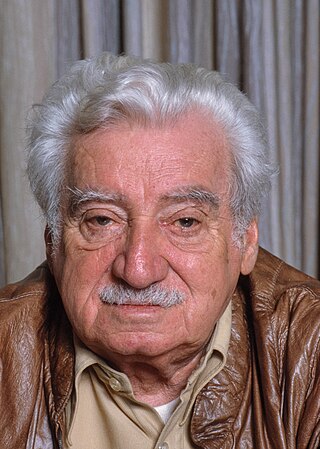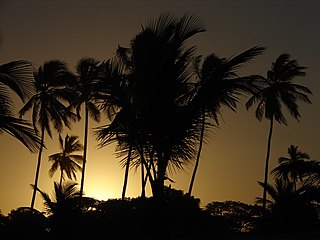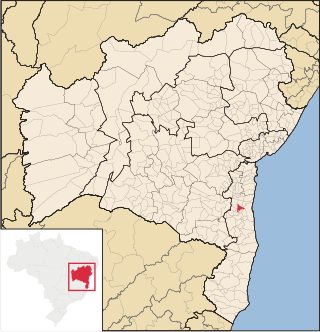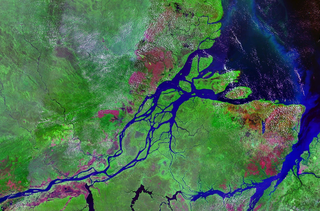
Bahia is one of the 26 states of Brazil, located in the Northeast Region of the country. It is the fourth-largest Brazilian state by population and the 5th-largest by area. Bahia's capital is the city of Salvador, on a spit of land separating the Bay of All Saints from the Atlantic. Once a stronghold of supporters of direct rule of Brazil by the Portuguese monarchy, and dominated by agricultural, slaving, and ranching interests, Bahia is now a predominantly working-class industrial and agricultural state. The state is home to 7% of the Brazilian population and produces 4.2% of the country's GDP.

Jorge Amado was a Brazilian writer of the modernist school. He remains the best-known of modern Brazilian writers, with his work having been translated into some 49 languages and popularized in film, including Dona Flor and Her Two Husbands in 1976. His work reflects the image of a Mestiço Brazil and is marked by religious syncretism. He depicted a cheerful and optimistic country that was beset, at the same time, with deep social and economic differences.

Ilhéus is a major city located in the southern coastal region of Bahia, Brazil, 211 km south of Salvador, the state's capital. The city was founded in 1534 as Vila de São Jorge dos Ilhéus and is known as one of the most important tourism centers of the northeast of Brazil.

Itacaré is a municipality in the cocoa zone of the state of Bahia in Brazil, south of Salvador.

The Vaza-Barris River is a river in northeastern Brazil. The Vaza-Barris originates in northeastern Bahia state, and flows east through Bahia and Sergipe states to empty into the Atlantic Ocean near São Cristóvão.

Itajuípe is a municipality in the state of Bahia in the North-East region of Brazil.

Almadina, Bahia is a municipality in the state of Bahia in the North-East region of Brazil. Almadina covers 245.27 km2 (94.70 sq mi), and has a population of 5,366 with a population density of 25 inhabitants per square kilometer.

Coaraci is a municipality in the state of Bahia in the North-East region of Brazil.

Uruçuca is a municipality in the state of Bahia in the North-East region of Brazil.

Cairu is a municipality in the state of Bahia in the North-East region of Brazil. The municipality consists of three islands: the Island of Cairu, which is only separated from the mainland by a narrow river; Tinharé Island, which has the dense tourist settlement of Morro de São Paulo to the north; and Boipeba Island.
Banda Vingadora is a Brazilian musical group formed in 2014 in the city of Itabuna, Bahia.

The Marajó Archipelago Environmental Protection Area is an environmental protection area in the state of Pará, Brazil. It protects the Marajó Archipelago, made up of marine fluvial islands in the area where the Amazon and Tocantins rivers converge and flow into the Atlantic. Covering almost 60,000 square kilometres (23,000 sq mi) it is larger than some countries in Europe.
The Wenceslau Guimarães Ecological Station is an ecological station in the state of Bahia, Brazil.

The Serra do Conduru State Park is a state park in the state of Bahia, Brazil. It protects an area of Atlantic Forest that is regenerating after damage from human intervention.

The Lagoa Encantada e Rio Almada Environmental Protection Area is an environmental protection area in the state of Bahia, Brazil.

The Serra Branca / Raso da Catarina Environmental Protection Area is an environmental protection area in the state of Bahia, Brazil. Its sandstone cliffs are home to the endangered Lear's macaw.

Cable News Network Brazil is a Brazilian news-based pay television channel and news website. Launched on 15 March 2020, CNN Brazil is owned by Novus Media, a joint-venture between Douglas Tavolaro, former header of Record's news division, and Rubens Menin, owner of MRV Engenharia. Novus Media has a licensing agreement with original CNN channel owned by Warner Bros. Discovery. CNN Brazil is the second local franchise of CNN in South America, after CNN Chile.

Subtropical Storm Ubá was the fourth tropical or subtropical cyclone to form in the South Atlantic Ocean in 2021. Ubá originated from an area of low pressure that formed off the coast of Rio de Janeiro and evolved into a subtropical cyclone on 10 December. The cyclone lingered for two days, before weakening back to a low-pressure area and dissipating on 13 December. Together with the South Atlantic Convergence Zone (SACZ), Ubá caused heavy rains in Minas Gerais, in Espírito Santo and mainly in Bahia. The storm became the deadliest South Atlantic (sub)tropical cyclone, with a death toll of 15.

Miss Grand Brazil 2019 was the second edition of the Miss Grand Brazil beauty pageant, held on February 28, 2019, at the Dall'Onder Grande Hotel in Bento Gonçalves, Rio Grande do Sul. Twenty-two contestants, who qualified for the national stage through state contests held by the Concurso Nacional de Beleza, competed for the title, of whom a nutrition student and model resident of Mooca representing the state of São Paulo, Marjorie Marcelle, was elected the winner. She later represented Brazil at the Miss Grand International 2019 contest held that year on October 25 in Venezuela, and was named the fourth runner-up.

The Brazilian cacao cycle or boom was a period in Brazil's economic history in which the country remained between first and second in world cacao production.


















